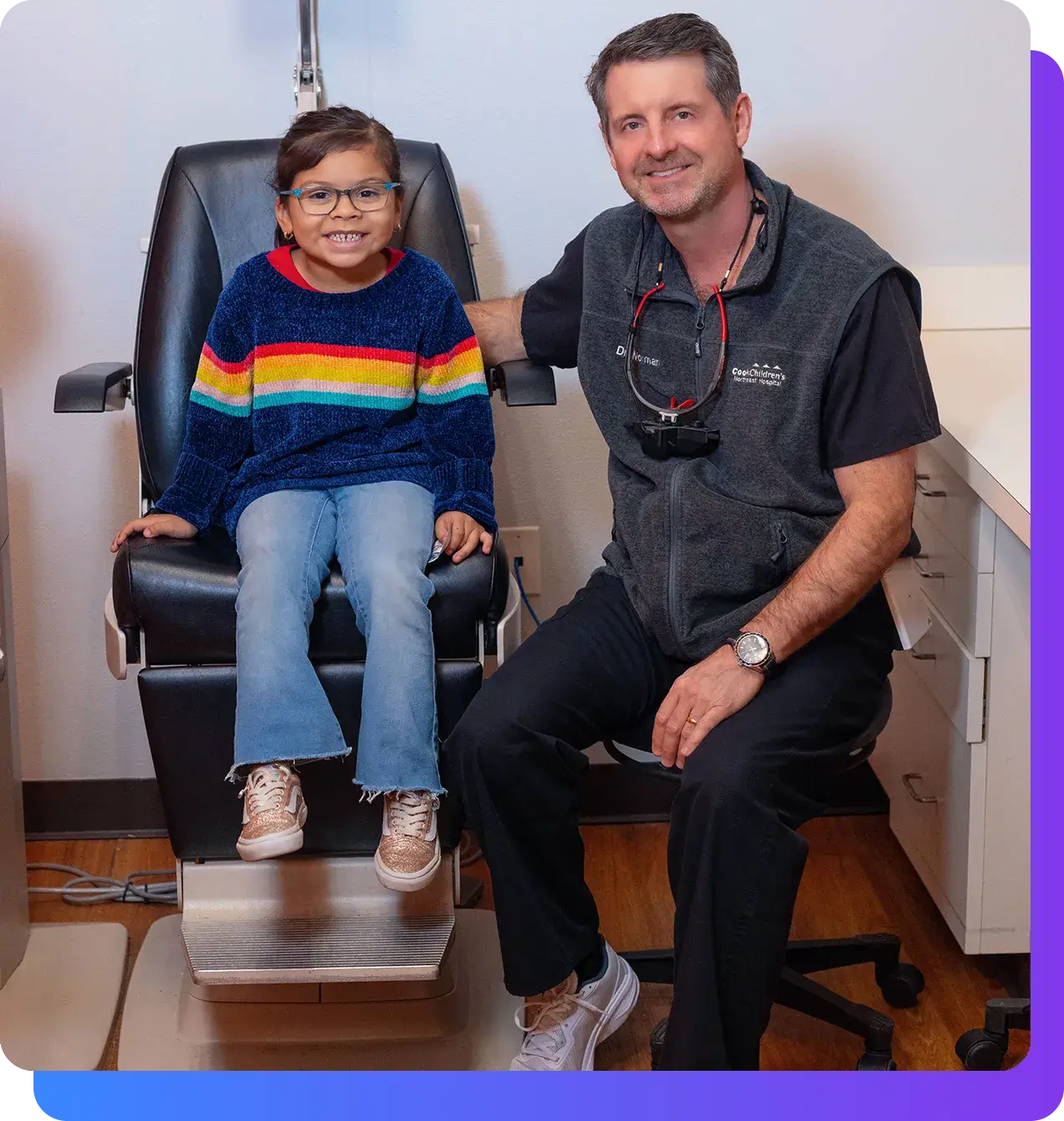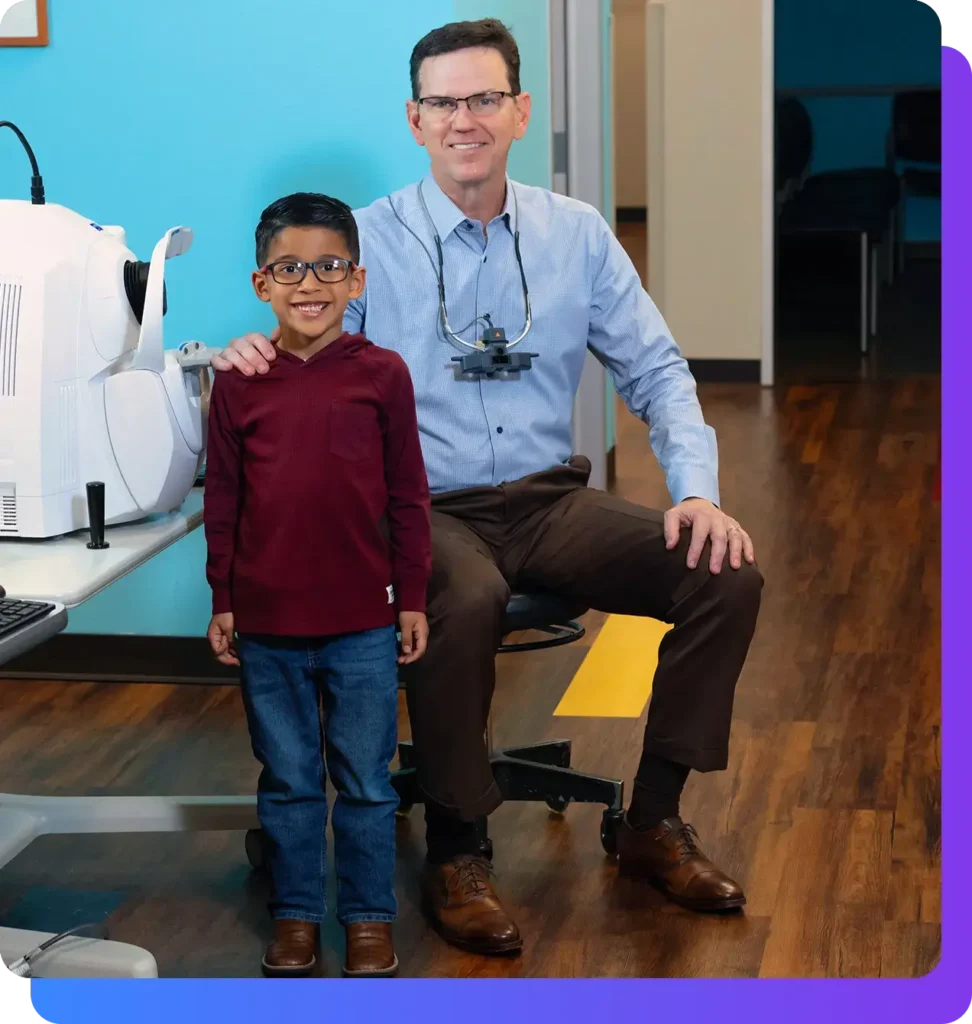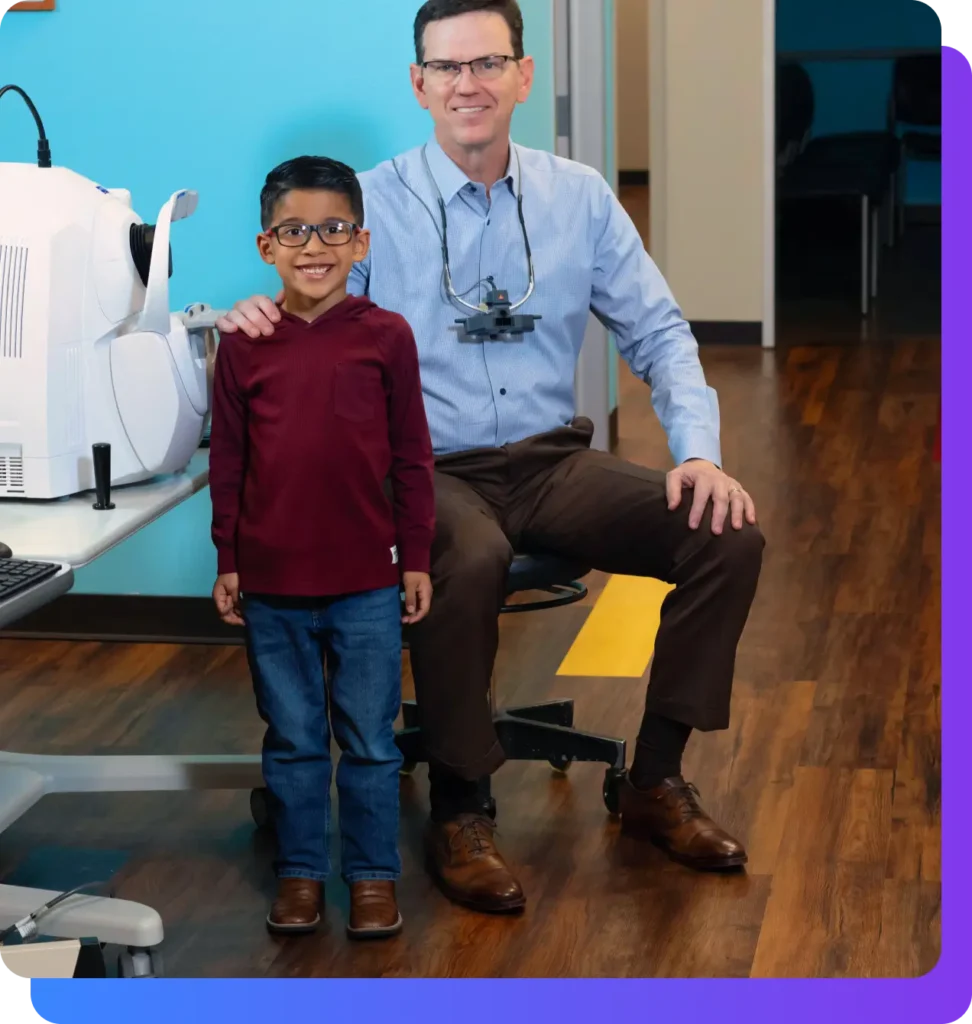Pediatric Esotropia (Inwardly Crossed Eyes)
Specialists in North Texas
Discovering that your child may be showing signs of pediatric esotropia, often referred to as “crossed eyes,” can be deeply concerning and confusing for any parent. Witnessing your infant or child struggle with this condition, which affects the alignment and coordination of the eyes, can evoke a range of emotions from worry to fear about how it might impact their vision and overall quality of life.
Expert Esotropia Treatment in North Texas
At Pediatric Eye Specialists, we understand these feelings and the myriad of questions that come with them. We’re dedicated to not only providing exceptional medical care but also offering support and understanding during this challenging time. Our team of specialists is equipped with the knowledge, experience, and compassionate approach necessary to guide your family through this journey. With our expertise in pediatric ophthalmology, we are committed to ensuring your child receives the best possible care and treatment, empowering them to achieve their brightest future.

The Basics: What is Pediatric Esotropia?
Pediatric esotropia, commonly known as “crossed eyes,” is an eye condition that manifests in early childhood, where one or both eyes turn inward towards the nose. This misalignment can be constant or intermittent and may vary in severity. It affects the way the eyes work together, potentially leading to problems with depth perception and binocular vision. The causes of pediatric esotropia are diverse, including genetic factors, muscle imbalances, or neurological conditions. It’s crucial to address this condition early, as it can impact a child’s visual development and may lead to amblyopia, also known as lazy eye, where the brain favors one eye over the other. Effective treatments are available, ranging from glasses and medical therapy to surgical interventions, each tailored to the child’s specific needs and condition. Early diagnosis and treatment are key to ensuring optimal visual development and function as the child grows.
Why Choose Pediatric Eye Specialists for Your Child's Esotropia?
The Most Experienced Team in North Texas
With over sixty-five years of collective pediatric ophthalmology expertise, we offer your child unparalleled collaborative care.
Five Convenient Locations
Easily accessible care with offices in Fort Worth, Denton, Keller, Mansfield, and Prosper,
Unrushed, Clear Communication
We take the time to discuss your child's diagnosis and treatment, ensuring all your questions are answered to ease your concerns.
Affiliated with Cook Children’s Hospital
Our partnership with Cook Children’s Hospital means if your child needs surgery, imaging, or other specialists, they will be treated in one of the nation’s leading pediatric hospitals.
Specialized Expertise
Our expertise means that more optometrists, doctors, and specialists refer their pediatric eye patients to Pediatric Eye Specialists than any other pediatric eye practice in North Texas.
Child and Family Focused
Kids love us, and we love kids! We provide a caring environment for your child and your family.
Advanced Diagnostic Technology
We have the most comprehensive pediatric diagnostic suite in North Texas, allowing for precise diagnosis and highly personalized treatment plans.
Every Child Needs Access to Expert Eye Care
Championing the right to sight, we help navigate insurance, cash pay, and Medicaid options to make superior eye care feasible for all children regardless of their socioeconomic status.

Benefits of Early Treatment of Infantile Esotropia
Treating pediatric esotropia early offers numerous benefits that extend beyond merely correcting the physical alignment of the eyes.
Success You Can Expect for Your Child
Clearer Vision
Treating esotropia in children not only corrects the immediate misalignment of their eyes but also significantly enhances their vision clarity and depth perception. This early intervention is key in preventing associated conditions like amblyopia, commonly known as lazy eye, ensuring a stronger visual foundation for their future.
Increased Social Confidence
Successful esotropia treatment can boost a child’s self-esteem and confidence, especially in social situations. When children feel more comfortable about their eye appearance, they are more likely to engage in eye contact and actively participate in interactions with peers, enhancing their social development.
Greater Educational Success
Effective esotropia treatment plays a crucial role in a child’s academic journey. Improved vision and binocular function contributes to a better learning experience, particularly in reading and other visually intensive tasks, setting them up for greater success in the classroom and beyond.
Real Stories,
Real Smiles.
“They were very good with my nonverbal toddler. It was the best doctor visit experience we have had yet. They were awesome, caring, and quick!.”

Amy Glover
Parent of Patient
“Today, Dr. Packwood saved my youngest from a life of blindness and worked a miracle for my family. I cannot express enough gratitude and thanks for their skillful surgery and expertise. 10 of 10 highly recommend.”

Atticus Lee
Parent of Patient
“The staff here is so amazing with my son. We had such a wonderful experience both at the office and for his surgery! I highly recommend Pediatric Eye Specialists!!!!“

Gianna Stutzman
Parent of Patient
“We are so grateful for the genuine care that Dr. Duff provided for our son Lorenzo, which prevented him from going blind! She is truly a gift to the community.“

JS Cocjin
Parent of Patient
“Professional, compassionate, kind and friendly. They took great care of my preemie baby from Day 1 of ROP. Very happy with how my daughter is progressing and has healthy eyes now.”

Suresh K.C.
Parent of Patient
“We’ve seen Dr. Hunt for the past 6 years since my daughter was 9 days old. We have multiple appointments each year and even eye surgery when she was 1. Our experience here has been fantastic every time and we highly recommend this group!.”

Mandy Edmondson
Parent of Patient
“Dr. Norman has always been very attentive and thorough with my daughter, who has Type 1 Diabetes. The staff are warm and always do their best to be accommodating. I highly recommend Dr. Norman.”

Tricia Moon
Parent of Patient
“Absolutely recommend! All around great experience! They made my son feel comfortable during the visit. Treatment was explained, and I walked out with no questions. I loved it. “

Cynthia Valero
Parent of Patient
“Great staff, great doctors; they know how to help ease kids’ fears and provide excellent service. Had to get my little one in same day for an eye injury, and they found a way to make it happen. Would 100% recommend.“

Kris K
Parent of Patient
Start your child’s journey to better vision today.
Embrace a future of clearer vision and confidence for your child. Contact us now to book your consultation at any of our convenient locations across the Metroplex.
Click to Explore Pediatric Esotropia
Causes of Pediatric Esotropia
Understanding the root causes of pediatric esotropia is essential for effective treatment and management. Esotropia, characterized by an inward turning of one or both eyes, can be influenced by several factors:
Genetic Predisposition
Often, esotropia runs in families, indicating a genetic component to its development. Children with a family history of esotropia or other forms of strabismus are at a higher risk.
Refractive Errors
Significant uncorrected refractive errors, particularly hyperopia (farsightedness), can lead to accommodative esotropia. In these cases, the child’s effort to focus their eyes correctly can cause them to cross.
Muscle Imbalance
An imbalance in the eye muscles can cause one eye to turn inward. This might be due to the muscles’ strength or control issues within the neurological system that coordinates eye movements.
Congenital Factors
Some babies are born with esotropia. In these cases, the condition is often noticed soon after birth and is referred to as congenital or infantile esotropia.
Neurological Conditions
Certain neurological disorders, including cerebral palsy and brain injuries, can be associated with the development of esotropia.
Premature Birth
Infants born prematurely are at an increased risk for developing various types of strabismus, including esotropia, possibly due to their underdeveloped visual system at birth.
Associated Syndromes
Esotropia can sometimes be a part of various syndromes or systemic conditions, necessitating a comprehensive medical evaluation to identify any underlying issues.
By understanding the causes of pediatric esotropia, Pediatric Eye Specialists can devise more effective, personalized treatment plans. Early detection and intervention are crucial in managing this condition effectively, ensuring better visual outcomes for the child.
Understanding these causes is vital for Pediatric Eye Specialists in diagnosing and formulating an effective treatment plan for esotropia.
Signs and Symptoms of Pediatric Esotropia: Identifying Early Indicators for Prompt Intervention
Recognizing the signs and symptoms of pediatric esotropia is crucial for early intervention and effective treatment. Parents and caregivers should be vigilant about the following indicators:
Crossed Eyes
The most obvious sign of esotropia is one or both eyes turning inward towards the nose. This may be constant or may only occur at certain times, such as when the child is focusing on an object, feeling tired, or ill.
Squinting
Children with esotropia may squint one eye, especially in bright sunlight, to improve their vision or reduce diplopia (double vision).
Tilting or Turning the Head
To compensate for misaligned vision, the child might tilt or turn their head in a specific direction to use their eyes more effectively.
Difficulty with Depth Perception
Due to the lack of proper binocular vision, children with esotropia may have trouble with activities that require depth perception, such as catching a ball.
Poor Vision in One Eye
If left untreated, esotropia can lead to amblyopia (lazy eye), where the brain starts ignoring the input from the misaligned eye, leading to poor vision in that eye.
Frequent Blinking or Rubbing Eyes
In an attempt to clear their vision, children with esotropia might blink frequently or rub their eyes.
Light Avoidance
Children might avoid looking at bright lights or have difficulty focusing on objects or faces.
Have Concerns?
Early detection of these signs and symptoms is essential for timely medical intervention. Pediatric Eye Specialists is equipped to provide thorough eye examinations and appropriate management for children with esotropia, ensuring the best possible outcomes for their visual health.
Diagnosing Esotropia in Children: Overview of the Diagnostic Process
The accurate diagnosis of pediatric esotropia is critical for determining the most effective treatment plan. Pediatric Eye Specialists employs a comprehensive approach to diagnose this condition:
Initial Clinical Examination
The first step involves a thorough eye examination. This includes assessing the child’s eye alignment and movement, checking for any refractive errors (like farsightedness), and evaluating their ability to focus.
Cover Test
This simple yet effective test involves the patient covering one eye at a time while the doctor observes how the uncovered eye moves. This helps identify whether the esotropia is constant or intermittent and which eye is affected.
Hirschberg Test
This test evaluates the corneal light reflex. By shining a light into the eyes, the doctor can observe the reflection of the light on the cornea, which aids in assessing the degree of eye turn.
Cycloplegic Refraction
To rule out or correct refractive errors, cycloplegic drops are used to temporarily paralyze the muscle that focuses the eye. This allows the specialist to accurately measure the child’s prescription.
Fundus Examination
An examination of the retina and optic nerve may be conducted to check for any underlying retina or optic nerve disorders.
Imaging Tests
In some cases, imaging studies like MRI or CT scans may be recommended to rule out any neurological causes of esotropia.
Visual Acuity Testing
This test assesses how well the child can see at different distances. It’s crucial for detecting any vision loss, especially important in identifying amblyopia (lazy eye).
Binocular Vision Assessment
This involves tests to evaluate how well the eyes work together. Poor binocular vision can be a consequence of esotropia.
Ocular Motility Examination
This test assesses the movement of the eyes in all directions to identify any restrictions or weaknesses in the eye muscles.
Through these diagnostic methods, Pediatric Eye Specialists can accurately diagnose pediatric esotropia and differentiate it from other types of eye misalignments. This thorough evaluation is essential for creating an effective, personalized treatment plan for each child.
Treatments for Pediatric Esotropia: Exploring Both Surgical and Nonsurgical Options
Pediatric esotropia, a form of strabismus where a child’s eyes turn inward, requires timely and effective treatment. Pediatric Eye Specialists offers a range of both surgical and nonsurgical options tailored to each child’s specific condition.
Nonsurgical Treatments:
Glasses for Refractive Correction: If the esotropia is caused by refractive errors like farsightedness, corrective lenses can often help realign the eyes.
Prism Lenses: Sometimes used as a temporizing measure, prisms bend light and compensate for eye misalignment.
Patching Therapy: Used primarily to treat amblyopia (lazy eye), which often accompanies esotropia, patching the dominant eye can help strengthen the weaker eye.
Orthoptic Exercises: These are visual exercises designed to improve eye coordination and binocular vision (the ability to use both eyes together).
Botulinum Toxin Injections: In certain cases, botulinum toxin (Botox) injections into the eye muscles can temporarily correct the alignment.
Surgical Treatments:
Strabismus Surgery: This is often the primary treatment for significant esotropia. The surgery involves adjusting the length or position of eye muscles to align the eyes properly.
Recession and Resection Procedures: These are common surgical methods where the eye muscles are either weakened (recession) or strengthened (resection) to correct the misalignment.
Adjustable Suture Surgery: Used in some cases, this technique allows for fine-tuning of the eye muscle position after surgery, sometimes leading to more precise outcomes.
Faden Operation (Posterior Fixation): This special type of strabismus procedure changes the action of an eye muscle by altering its point of attachment, helping to control certain types of eye movements.
Comprehensive Approach:
- Pediatric Eye Specialists focuses on a comprehensive approach, often combining treatments for optimal outcomes. For instance, glasses may be used alongside surgery, or patching and orthoptic excercises may follow surgical intervention to enhance results.
- Regular follow-up is essential to monitor the child’s progress and make necessary adjustments in the treatment plan.
- Parental involvement and education are key components of successful treatment, ensuring that parents understand the importance of adherence to therapy or postsurgical care.
Through these diverse treatment options, Pediatric Eye Specialists aims to not only correct the eye alignment but also to improve the child’s overall visual function and quality of life. Each treatment plan is customized, considering the unique needs of the child and the specific characteristics of their esotropia.
Typical Expected Outcomes: Insights into Prognosis and Potential Improvements for Pediatric Esotropia
When it comes to pediatric esotropia, understanding the typical expected outcomes is crucial for parents. At Pediatric Eye Specialists, we aim to provide clear, realistic insights into the prognosis and potential improvements that can be achieved through treatment.
Improved Eye Alignment
One of the primary outcomes of treating esotropia is better alignment of the eyes. This improvement is crucial for the child’s visual appearance and can significantly enhance their psychosocial well-being.
Enhanced Visual Function
Successful treatment often leads to improved binocular vision, which is essential for depth perception and overall visual functionality. This enhancement is particularly important for developing normal vision patterns in young children.
Reduction in Symptomatic Discomfort
Some children experience symptomatic relief from issues like eye strain, double vision, or headaches as a result of effective esotropia treatment.
Prevention or Treatment of Amblyopia
Early and effective intervention is key to preventing or treating amblyopia, also known as lazy eye, which is a common complication associated with untreated esotropia.
Success Rates of Surgical Interventions
For children undergoing surgical treatment, there is a high rate of success in correcting eye misalignment. However, some cases may require more than one surgical procedure to achieve the desired outcome.
Overall Enhancement of Quality of Life
Beyond physical eye correction, successful esotropia treatment can have a profound impact on the child’s quality of life, including improved self-esteem, better academic performance, and enhanced social skills.
It’s important for parents to maintain realistic expectations, as individual outcomes can vary based on factors like the child’s age, severity of esotropia, and the presence of other eye conditions. Pediatric Eye Specialists is dedicated to providing personalized care and support throughout the treatment journey, aiming for the best possible outcomes for each child.
Secure A Brighter Future: Schedule Your Child's Esotropia Consultation Today
Facing pediatric esotropia can be daunting, but you’re not alone. At Pediatric Eye Specialists, we’re committed to providing expert care with compassion and understanding. Don’t let uncertainty affect your child’s vision and quality of life. Schedule a consultation today, and take the first step towards the best possible care for your child’s visual health. Together, we can work towards a bright future for your child.

Start your child’s journey to better vision today.
Embrace a future of clearer vision and confidence for your child. Contact us now to book your consultation at any of our convenient locations across the Metroplex.
What is the earliest age at which pediatric esotropia can be diagnosed?
Pediatric esotropia can often be identified in infancy, sometimes as early as the first few months of life. Early signs can be subtle, so regular eye examinations are important for early detection.
Can pediatric esotropia occur in children without any family history of the condition?
Yes, pediatric esotropia can develop in children with no family history of the condition. While genetics can play a role, there are various other factors, including birth defects or neurological issues, that can contribute to its development.
Is it necessary for my child with esotropia to wear glasses even if they have good vision?
Glasses may be prescribed for children with esotropia, even if they have good vision. They can help align the eyes, especially in cases of accommodative esotropia, where focusing difficulties contribute to eye misalignment.
How long does treatment for pediatric esotropia typically last?
The duration of treatment for pediatric esotropia varies based on the severity of the condition and the response to treatment. It can range from a few months to several years, with regular monitoring and adjustments as needed.
Will delaying treatment for esotropia affect my child’s vision development?
Delaying treatment for esotropia can impact a child’s visual development, including the risk of developing amblyopia (lazy eye). Early intervention is crucial for optimal visual outcomes.
Can pediatric esotropia lead to other eye problems?
Untreated pediatric esotropia can lead to other eye issues, such as amblyopia, decreased depth perception, and potential challenges with binocular vision. Early treatment helps to mitigate these risks.
Is surgery always required to treat pediatric esotropia?
Surgery is not always required for pediatric esotropia. The treatment plan depends on the specific type and severity of esotropia. In some cases, glasses or other nonsurgical methods may be effective.
How does congenital esotropia differ from other forms of the condition?
Congenital esotropia is a specific type of esotropia that is present at birth or develops within the first six months of life. Unlike other forms that may develop later and be associated with various diseases or conditions, congenital esotropia is characterized by a significant inward turning of the eyes and is often more pronounced and consistent.
Can pediatric esotropia be linked to preterm birth?
Yes, children born prematurely may have a higher risk of developing various eye conditions, including pediatric esotropia. The association is due to the incomplete development of the eye’s muscles and neural pathways that can occur with preterm birth. A low birth weight can be a potential corollary sign of a lack of full prenatal development that might affect visual development.
What is the role of extraocular muscles in pediatric esotropia?
Extraocular muscles control eye movement. In pediatric esotropia, these muscles may not work together properly, causing one or both eyes to turn inward. Treatment often involves methods to strengthen or correct the function of these muscles.
My child has been diagnosed with Duane syndrome. Could this be related to their esotropia?
Yes, Duane syndrome is a congenital eye movement disorder that restricts the ability of the eye to move outward and sometimes inward, which can be associated with esotropia. It is caused by abnormal development of the cranial nerves controlling eye movement.
What is dissociated vertical deviation (DVD), and how is it related to esotropia?
Dissociated vertical deviation (DVD) is a condition often seen in patients with esotropia where one eye drifts upwards when the other eye is fixating or during occlusion. It is considered a type of strabismus and can complicate both the diagnosis and treatment of esotropia.
How is the angle of esotropia measured, and why is it important?
The angle of esotropia is measured using specific instruments and tests by an ophthalmologist or orthoptist to determine the degree of eye turn. This measurement is crucial for planning treatment, especially if surgery is required.
Can nystagmus occur alongside pediatric esotropia, and how are they connected?
Nystagmus, which is an involuntary, repetitive movement of the eyes, can sometimes occur with pediatric esotropia. Both conditions can affect a patient’s ability to maintain stable fixation and can influence visual development and the quality of stereopsis, which is the perception of depth.
Is there a way to enhance peripheral vision in children with esotropia?
Interventions that straighten eyes, usually glasses or surgery, improve peripheral vision.
How do cranial nerves affect pediatric esotropia?
Cranial nerves, specifically the third (oculomotor), fourth (trochlear), and sixth (abducens) nerves, are responsible for eye movement control. Any anomalies or nerve palsies can lead to misalignment of the eyes, possibly to include esotropia.
What is the difference between binoculars and monocular vision in the context of pediatric esotropia?
Binocular vision refers to the ability to use both eyes together to perceive depth, while monocular vision involves using one eye at a time due to the misalignment. Treatment for esotropia aims to restore or improve binocular vision by realigning the eyes.
How does the vestibular system affect esotropia in children?
The vestibular system, which is responsible for balance and spatial orientation, works closely with the visual system. Issues with the vestibular system can sometimes contribute to eye alignment problems like esotropia, as the body struggles to coordinate balance with visual input.
Can esotropia be a sign of global developmental delay in children?
While esotropia is primarily an eye condition, it can occasionally be associated with broader health issues, such as global developmental delay. It’s important for children with esotropia to undergo comprehensive evaluations to rule out or address any other developmental concerns.
My child has been diagnosed with monofixation syndrome. Could this lead to esotropia?
Monofixation syndrome is a condition where a person has binocular vision but with a small degree of misalignment that does not affect their depth perception significantly. While it can be associated with esotropia, it is often a stable condition that does not necessarily require the same treatments as esotropia.
Can sixth nerve palsy cause esotropia in children?
Yes, sixth nerve palsy, which affects the lateral rectus muscle responsible for moving the eye outward, can lead to esotropia. This muscle weakness or paralysis results in the eye turning inwards, and it may require specialized treatment depending on the underlying cause.
How does accommodation in the human eye relate to pediatric esotropia?
Accommodation is the process by which the eye changes optical power to maintain a clear image or focus on an object as its distance varies. In children, excessive accommodation can sometimes lead to esotropia, particularly if there is uncorrected hyperopia (farsightedness). Glasses or contact lenses to correct the refractive error can often reduce the accommodative effort and correct the inward turning of the eye.